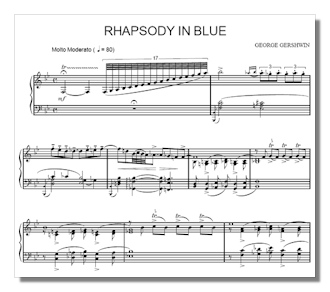
The Internet's Premier Classical Music Source
Related Links
-
Find CDs & Downloads
Amazon - UK - Germany - Canada - France - Japan
ArkivMusic - CD Universe
Find DVDs & Blu-ray
Amazon - UK - Germany - Canada - France - Japan
ArkivMusic-Video Universe
Find Scores & Sheet Music
Sheet Music Plus -
Search Amazon
Recommended Links
Site News
George Gershwin
Rhapsody in Blue (1924)

A few works create new worlds of music: Beethoven's Fifth and Ninth Symphonies, Schubert's Unfinished, Mendelssohn's Octet, Wagner's Ring, Mahler's Lieder eines fahrenden Gesellen, Debussy's Images, Stravinsky's Le Sacre du printemps, and this among them. With his first major piece, Gershwin invented a unique symphonic idiom, to this day still argued over. Gershwin, of course, was not the first to blend jazz and classical music. One could make cases for Debussy, Scott Joplin, or Milhaud as important pioneers and, even better, as creators of masterworks which used jazz. All of them, however, had exploited jazz's "chamber" qualities. From the Rhapsody's opening clarinet wail, Gershwin created not symphonic jazz, but the Gershwin idiom: an outdoor, urban, big-hearted, super-Romantic, and thoroughly assured poetry.
The Rhapsody in Blue (a wonderful title, courtesy of George's brother, Ira) has its detractors, mostly those who know so much about music that they forget to listen to it. As its title implies, the work is a bit loose – if you want Beethoven cohesion, look someplace else – but its invention carries most listeners along. Gershwin put in a slew of great tunes, probably enough for three different works. Is this a bug or a feature? Relax and enjoy. The final plunge to the finish line will most likely bring you to your feet. Gershwin builds in a standing ovation.
Copyright © 1996 by Steven Schwartz. All Rights Reserved.













